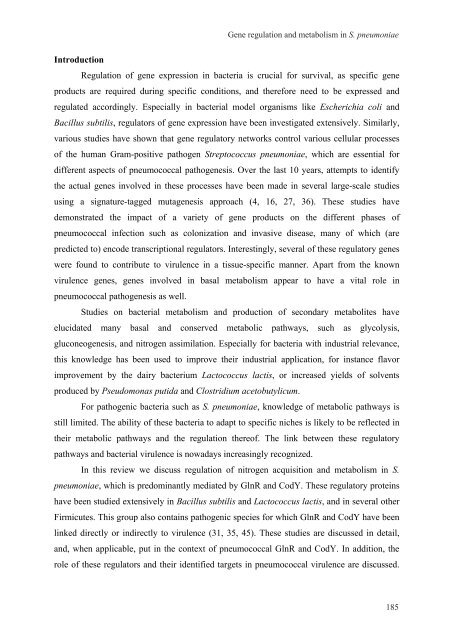Gene regulation in Streptococcus pneumoniae - RePub - Erasmus ...
Gene regulation in Streptococcus pneumoniae - RePub - Erasmus ...
Gene regulation in Streptococcus pneumoniae - RePub - Erasmus ...
You also want an ePaper? Increase the reach of your titles
YUMPU automatically turns print PDFs into web optimized ePapers that Google loves.
Introduction<br />
Regulation of gene expression <strong>in</strong> bacteria is crucial for survival, as specific gene<br />
products are required dur<strong>in</strong>g specific conditions, and therefore need to be expressed and<br />
regulated accord<strong>in</strong>gly. Especially <strong>in</strong> bacterial model organisms like Escherichia coli and<br />
Bacillus subtilis, regulators of gene expression have been <strong>in</strong>vestigated extensively. Similarly,<br />
various studies have shown that gene regulatory networks control various cellular processes<br />
of the human Gram-positive pathogen <strong>Streptococcus</strong> <strong>pneumoniae</strong>, which are essential for<br />
different aspects of pneumococcal pathogenesis. Over the last 10 years, attempts to identify<br />
the actual genes <strong>in</strong>volved <strong>in</strong> these processes have been made <strong>in</strong> several large-scale studies<br />
us<strong>in</strong>g a signature-tagged mutagenesis approach (4, 16, 27, 36). These studies have<br />
demonstrated the impact of a variety of gene products on the different phases of<br />
pneumococcal <strong>in</strong>fection such as colonization and <strong>in</strong>vasive disease, many of which (are<br />
predicted to) encode transcriptional regulators. Interest<strong>in</strong>gly, several of these regulatory genes<br />
were found to contribute to virulence <strong>in</strong> a tissue-specific manner. Apart from the known<br />
virulence genes, genes <strong>in</strong>volved <strong>in</strong> basal metabolism appear to have a vital role <strong>in</strong><br />
pneumococcal pathogenesis as well.<br />
Studies on bacterial metabolism and production of secondary metabolites have<br />
elucidated many basal and conserved metabolic pathways, such as glycolysis,<br />
gluconeogenesis, and nitrogen assimilation. Especially for bacteria with <strong>in</strong>dustrial relevance,<br />
this knowledge has been used to improve their <strong>in</strong>dustrial application, for <strong>in</strong>stance flavor<br />
improvement by the dairy bacterium Lactococcus lactis, or <strong>in</strong>creased yields of solvents<br />
produced by Pseudomonas putida and Clostridium acetobutylicum.<br />
For pathogenic bacteria such as S. <strong>pneumoniae</strong>, knowledge of metabolic pathways is<br />
still limited. The ability of these bacteria to adapt to specific niches is likely to be reflected <strong>in</strong><br />
their metabolic pathways and the <strong>regulation</strong> thereof. The l<strong>in</strong>k between these regulatory<br />
pathways and bacterial virulence is nowadays <strong>in</strong>creas<strong>in</strong>gly recognized.<br />
<strong>Gene</strong> <strong>regulation</strong> and metabolism <strong>in</strong> S. <strong>pneumoniae</strong><br />
In this review we discuss <strong>regulation</strong> of nitrogen acquisition and metabolism <strong>in</strong> S.<br />
<strong>pneumoniae</strong>, which is predom<strong>in</strong>antly mediated by GlnR and CodY. These regulatory prote<strong>in</strong>s<br />
have been studied extensively <strong>in</strong> Bacillus subtilis and Lactococcus lactis, and <strong>in</strong> several other<br />
Firmicutes. This group also conta<strong>in</strong>s pathogenic species for which GlnR and CodY have been<br />
l<strong>in</strong>ked directly or <strong>in</strong>directly to virulence (31, 35, 45). These studies are discussed <strong>in</strong> detail,<br />
and, when applicable, put <strong>in</strong> the context of pneumococcal GlnR and CodY. In addition, the<br />
role of these regulators and their identified targets <strong>in</strong> pneumococcal virulence are discussed.<br />
185<br />
185

















